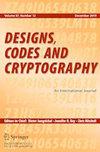四元加法码的渐近特性
IF 1.4
2区 数学
Q3 COMPUTER SCIENCE, THEORY & METHODS
引用次数: 0
摘要
让\(n_k(s)\)是存在四元加法\([n,k,n-s]_4\)-编码的最大长度n。我们解决了一个自然渐近问题,即确定 s 变为无穷大时 \(n_k(s)/s\) 的 lim sup (\lambda _k),以及 s 的最小值使得 \(n_k(s)/s=\lambda _k.\)。我们新的四元加法码族的参数是\([4^k-1,k,4^k-4^{k-1}]_4=[2^{2k}-1,k,3\cdot 2^{2k-2}]_4\) (其中\(k=l/2\)并且 l 是奇整数)。这些都是恒重码。与内码 \([3,2,2]_2\)连接得到的二进制码等价地满足格里斯梅尔约束。证明是通过 \(PG(l-1,2)\) 中的多行集来实现的。本文章由计算机程序翻译,如有差异,请以英文原文为准。
An asymptotic property of quaternary additive codes
Let \(n_k(s)\) be the maximal length n such that a quaternary additive \([n,k,n-s]_4\)-code exists. We solve a natural asymptotic problem by determining the lim sup \(\lambda _k\) of \(n_k(s)/s\) for s going to infinity, and the smallest value of s such that \(n_k(s)/s=\lambda _k.\) Our new family of quaternary additive codes has parameters \([4^k-1,k,4^k-4^{k-1}]_4=[2^{2k}-1,k,3\cdot 2^{2k-2}]_4\) (where \(k=l/2\) and l is an odd integer). These are constant-weight codes. The binary codes obtained by concatenation with inner code \([3,2,2]_2\) meet the Griesmer bound with equality. The proof is in terms of multisets of lines in \(PG(l-1,2)\).
求助全文
通过发布文献求助,成功后即可免费获取论文全文。
去求助
来源期刊

Designs, Codes and Cryptography
工程技术-计算机:理论方法
CiteScore
2.80
自引率
12.50%
发文量
157
审稿时长
16.5 months
期刊介绍:
Designs, Codes and Cryptography is an archival peer-reviewed technical journal publishing original research papers in the designated areas. There is a great deal of activity in design theory, coding theory and cryptography, including a substantial amount of research which brings together more than one of the subjects. While many journals exist for each of the individual areas, few encourage the interaction of the disciplines.
The journal was founded to meet the needs of mathematicians, engineers and computer scientists working in these areas, whose interests extend beyond the bounds of any one of the individual disciplines. The journal provides a forum for high quality research in its three areas, with papers touching more than one of the areas especially welcome.
The journal also considers high quality submissions in the closely related areas of finite fields and finite geometries, which provide important tools for both the construction and the actual application of designs, codes and cryptographic systems. In particular, it includes (mostly theoretical) papers on computational aspects of finite fields. It also considers topics in sequence design, which frequently admit equivalent formulations in the journal’s main areas.
Designs, Codes and Cryptography is mathematically oriented, emphasizing the algebraic and geometric aspects of the areas it covers. The journal considers high quality papers of both a theoretical and a practical nature, provided they contain a substantial amount of mathematics.
 求助内容:
求助内容: 应助结果提醒方式:
应助结果提醒方式:


